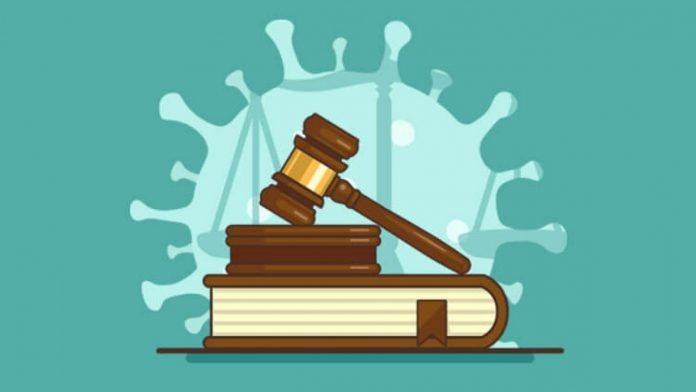This article is written by Saloni Chitlangia, pursuing Diploma in Intellectual Property, Media and Entertainment Laws from LawSikho. The article has been edited by Prashant Baviskar (Associate, LawSikho) and Ruchika Mohapatra (Associate, LawSikho).
Table of Contents
Introduction
The legal system of a country is one of the most important elements of a free and democratic country. Its proper running ensures that the country does not fall into chaos. In these tough times of an unprecedented crisis, every part of an economy has been hit hard, even the government machinery designed to run a country. The court system has been hit hard by the measures brought to control the pandemic like lockdowns. In these trying times, many professions have seen many job losses and law is no different. In this article, I will be focusing on the plight of the legal system during the COVID-19 and analysing the working of the Indian legal system. Indian laws are fully capable of solving issues of citizens and also these laws evolve with time according to the needs of the society. It is interesting to see how the Judiciary and the government is moulding the Indian Legal System in the spread of the COVID-19 pandemic spread all over the world. It can be observed by deep study into the Indian legal system and the current scenario that the judiciary and lawyers work tirelessly to make sure that the law is not led down and the duty of the legal system to render justice is not paused even in such difficult times.
Access to justice during COVID-19
Recently, Coronavirus or COVID-19 not only emerged but rapidly became a worldwide problem. The Coronavirus (COVID-19) pandemic caused the entire world to shut down and also impacted the business capabilities around the world were from a small activity of selling newspapers on the streets to big stock market offices, factories, etc. were facing a lock-down. Governments laid proclamations on ‘quarantine-when-healthy’ rather than ‘quarantine-when-infected’ to reduce the pace and scope of the spread of infection and this happened for the first time in history. In the midst of Coronavirus, the whole of India went into lockdown from 24th March 2020 owing to which many of the activities across the country had to be shut down. The strict lockdown made our life monotonous as well as more difficult because we are after all social beings and not being able to connect made us dull. Heart-wrenching news of daily wage workers stranded without food and walking hundreds of kilometres to reach home and get the ration advantage was seen. Thus, while the boredom was more of a personal issue, attention ought to be pointed to the thousands of labourers who were walking considerable distance to reach their homes. The case for all the middle-class families who were suffering due to lack of work was also not different. The lockdown, thus, impedes movement for work as well as other activities.
The Indian Judiciary came under immense pressure to balance both public health and provide access to justice. Although the pandemic started gaining ground in February the Supreme Court was open till the third week of March. The Supreme Court issued an order extending the period of limitation in all of the proceedings with effect from March. This decision was taken before the lockdown which suggests that the Supreme Court was conscious of the prevailing situation.
While the Indian legal system has many commendable and efficient elements it also has certain backdrops which delay or deny justice in certain cases. Already the Indian Courts were facing issues of pendency of cases and adding to that due to the pandemic, the courts were closed and were unable to work the way they used to before the lockdown. With the rise in pandemic and the increasing number of cases due to the shutdown of all the courts, the Supreme Court declared that it will hear cases on an urgent basis through video conferencing. Thus, the Supreme Court was enthusiastic in approaching the digital world by bringing changes at a faster pace because of the unprecedented arrival of the COVID-19 as well as the lockdown measures implemented by the government which was keeping the judges, lawyers, and litigants at their homes.
What are “Extremely Urgent” matters?
Taking note of the situation, the Supreme Court through suo motu cognizance issued notices regarding the functioning of courts via video conferencing only between May 18 to June 19 for the matters listed as “extremely urgent”. It also brought a helpline to help the advocates with E-Fillings and virtual hearing. The Bombay High Court has also taken a similar stance from April 17. But the problem of these hearings was that not only were they reserved for urgent cases that too only on dates given by the court but it was also not clearly stated by the Apex Court as to which type of cases were to be considered as “extremely urgent.” However, by observing the matters the court took up it can be said that following are the matters which were considered “extremely urgent” by the court:
1. Cases related to personal protective equipment for doctors and medical personnel,
2. Cases related to the welfare of Indian migrant workers,
3. Cases related to citizens stuck in other countries,
4. Cases related to guidelines to be notified to prevent the spread of COVID-19,
5. Cases related to protection-related victims of the recent riots in Delhi.
Hence it is still not clear exactly which category of cases was to be considered as “extremely urgent” by the courts, nor was there a guideline for the same. Additionally, the parties and the advocates had no means to approach the court if the registry decided to put their case out of the urgent cases list. This urgent clause could also have been misused as those who have strong ties with the High Court can make their case urgent or use their power to bury a case from the urgent case clause. This kind of misuse reduces the faith that the common people put in the judiciary.
Commercial cases
Through observation of the types of cases heard by the Supreme Court and the High Courts it can also be noticed that various commercial matters were given importance by the Indian Judiciary in the midst of Coronavirus lockdown.
The Supreme Court heard the case of SEBI v. Pravin Kumar Tayal and Ors. which was related to the application in relation to the extension of the duration of time to make the required payment for penalties charged by SEBI and the court.
The Apex Court also attended to issues related to the functioning of the Serious Fraud Investigation Office in Vivek Harivyasi v. SFIO.
In the case of M/s. Uptron Powertronics Ltd and Ors. V. Om Prakash Punyani and Ors. The Supreme Court looked into stay orders on warrants of cases in relation to non-release of undisputed levies of salaries of employees.
The Bombay High Court in Rural Fairprice Wholesale Limited & Anr. v. IDBI Trusteeship Services Limited & Ors. had recently issued interim orders to retrain IDBI Bank to temporarily stop them from selling the shares of the company- Future Retail Ltd., which was pledged as security for debentures which had been issued by the plaintiff. It was held for the court considering the market situation due to COVID-19, issued a temporary injunction on the selling of the pledged shares.
Challenges concerning virtual court hearings
Virtual court hearings are chosen by the Supreme Court to start hearing and resolving matters, where litigants and parties to the matters are able to present and argue before the court through videoconferencing. It is not the first time in the history of the legal system of India that this kind of hearings has taken place. It was first in the year 2002 that the Apex Court allowed audio-visual equipment to be used in civil cases. After which video-conferencing was taken up by the Supreme Court in the evidence stage of criminal cases. Some of the jails also got equipped with video-conferencing in 2014. In between the year, 2017 to 2019 various family courts and jails started having video-conferencing setup.
The noble objective of the virtual court hearing was to render justice in the difficult times of pandemic all over the globe and not only the Indian courts but the United States and United Kingdom Courts also adopted the concept of Virtual Courts. However, the courts in India are far from availing these services to everyone and the experiences in relation to the virtual court hearing have brought varied opinions. Justice D.Y. Chandrachud while presiding in a webinar rightly pointed out that open courts are considered to be the “spine” of the Indian legal system. He also added to this view that virtual courts cannot be a complete substitute to usual open courts, the Indian Judiciary has opted for video-conferencing to hear matters only because there was no choice left but to resort to it.
Many lawyers and legal scholars are of the view that unlike the courts of advanced countries, Indian courts are not properly equipped with the technology of video conferencing. Courts in the metropolitan cities like Delhi and Mumbai might have stepped up to the online shift but there are various other cities in which courts are incapable of making the virtual shift due to technical difficulties and network issues. There are around 672 district courts in India from where the foundation of litigation begins. District courts present in tribal and rural areas face serious challenges of accessibility of the internet and broadcast infrastructure. Most of the population around the country don’t have access to proper technology to avail of such service as there is still a lot of disparity between the rich and poor. This can lead to discrimination because these kinds of services would only be feasible for the rich and so most of the urgent cases taken by the courts would belong to those who are from influential families. Apart from the situation of courts, it has to be taken into consideration that many of the advocates and litigants do not have proper internet and technological facilities and the knowledge to be well versed with the system of video-conferencing and to do online hearings.
Many advocates have reported the issue that they have been facing in keeping their points and objecting to the opposing counsel’s arguments in between the session of hearings, which have led to a loss to them and their clients. There are a lot of times when Judges and advocates are not able to communicate properly due to inaudibility which unfortunately creates confusion and increases the pendency of cases.
It has been rightly pointed out by Senior Advocate Mr N Hariharan at the Delhi High Court that due to technical glitches faced in video streaming might affect Fair Trials. In the course of Fair Trials, facial expressions and various other factors are noted to come to a conclusion in a criminal matter which might get overshadowed due to glitches in the usage of technology. The physical dimension of court hearing and arguments cannot be totally covered by virtual courts until and unless all the courts, lawyers and parties are fully equipped with proper technological equipment.
Issues related to the privacy of information and documents are being raised as third-party apps are being used by the courts to conduct video conferencing. The question of liability is unanswered as if in any case someone’s personal information is used by anyone else while cases are being heard by the Judiciary. Therefore, these views are elucidating the point that the strict procedures that were to be followed according to the law were not being followed during the virtual court hearing.
Conclusion
The Indian Legal System is one of the most efficient in the world. Our codes, statutes and customary laws form the base of our Legal System while national spirit and customary values are deep-rooted in our legal system which makes sure that justice is never denied. However, India is a diversified country where the conditions are different from all the states. Courts, litigants and lawyers in various cities and states deal with different kinds of technological, economic and social advancements. Thus, it has to be realised that a decision taken by the Apex Court or the government has to be in accordance with the disparities. Even in the difficult times the judiciary and the lawyers have succeeded to prove their capability to keep up the spirit of the law in India but the judiciary still has to definitely mould itself according to the need of the hour in order to maintain peace and order in the nation.
References
- https://lexlife.in/2021/06/29/covid-19-and-administration-of-justice-a-reflection-on-indian-perspective/
- https://main.sci.gov.in/supremecourt/2020/10787/10787_2020_31_1501_26732_Judgement_08-Mar-2021.pdf
- https://scroll.in/latest/962838/despite-public-health-crisis-it-is-courts-duty-to-protect-rights-of-citizens-justice-chandrachud
Students of Lawsikho courses regularly produce writing assignments and work on practical exercises as a part of their coursework and develop themselves in real-life practical skills.
LawSikho has created a telegram group for exchanging legal knowledge, referrals, and various opportunities. You can click on this link and join:
https://t.me/joinchat/J_0YrBa4IBSHdpuTfQO_sA
Follow us on Instagram and subscribe to our YouTube channel for more amazing legal content.
 Serato DJ Crack 2025Serato DJ PRO Crack
Serato DJ Crack 2025Serato DJ PRO Crack











 Allow notifications
Allow notifications



